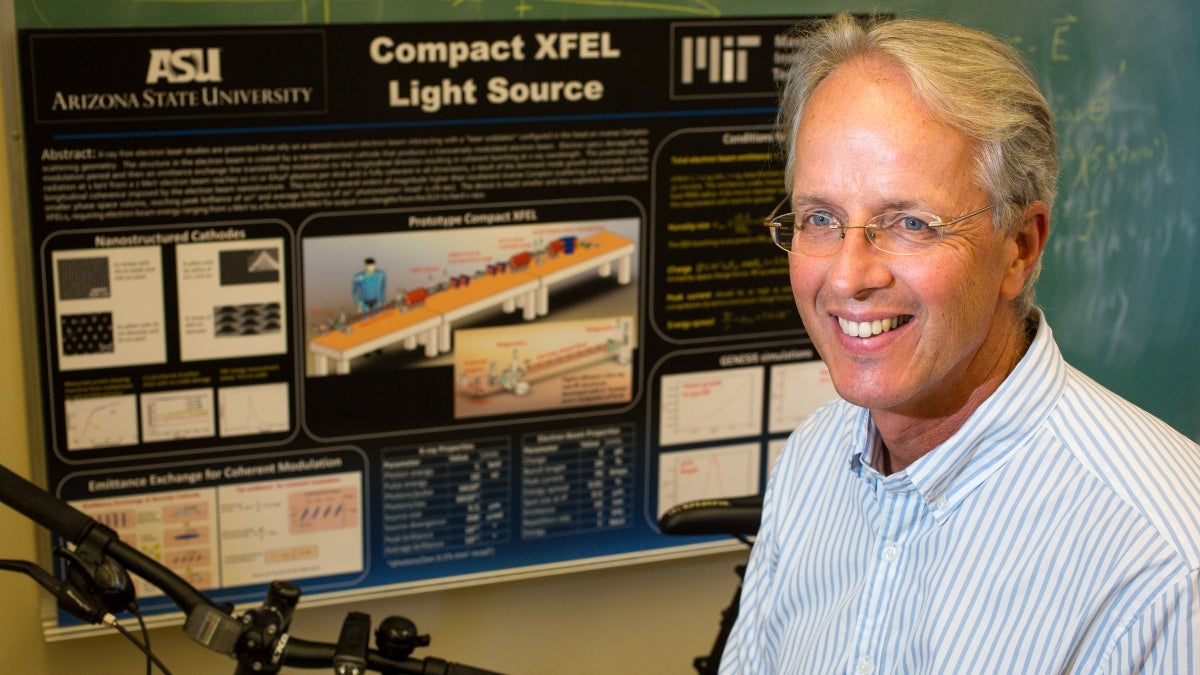Free electron lasers — powerful devices that can peer deep into molecular structure and the ultrafast timescales of chemistry — cost billions to build and are miles long, but an Arizona State University professor is constructing a version that can fit on a tabletop. And it will cost a fraction of the price of its larger peers.
This compact free electron laser will be accessible to millions of scientists, instead of hundreds, advancing countless fields of research and potentially expanding medical uses.
“There’s almost no limit to what it can do,” said William Graves, associate professor in the university’s Physics Department and Biodesign Institute. “These things are brand new; they’ve never existed before. We think it’s really going to revolutionize X-ray science.”
Free electron lasers, which use a high-power laser to make X-rays with electrons, have been around for five years, but only a few exist. They cost $1 billion to build, they can be miles long, and they cost $100 million annually to operate. Access to them is highly sought after by scientists, with 80 percent of applications rejected.
Graves’ compact version will be about 3 feet long, cost about $10 million to build, operate on a $1 million annual budget, and require three people to run it.
“Not only can we do great science with this, but lots of people can do great science with this,” he said. “It’s like taking a huge synchrotron (particle accelerator) at a national lab and we’re sticking it over in (the Biodesign department). All the things they do with a synchrotron, we can do here.”
An accelerator physicist and a veteran of MIT and Brookhaven National Lab, Graves has worked on the big particle accelerators, which make X-ray light sources, but in the past 10 years has been working on small free electron lasers.
Graves came to ASU from the Massachusetts Institute of Technology to work on this new generation of imaging technology because, “ASU is giving me the chance to build it.”
Graves came to ASU from the Massachusetts Institute of Technology because “Petra Fromme and John Spence at ASU demonstrated they have the vision and resources to make this project successful,” Graves said. Fromme directs the Biodesign Institute’s Center for Applied Structural Discovery and is a professor in ASU's Department of Chemistry and Biochemistry. Spence is a Regents' Professor and the Richard Snell Professor of Physics at ASU.
“ASU has stepped up to the plate and funded the first version of it,” Graves said. “We’re building it as a collaboration. We’ll initially run it at MIT, but as soon as our laboratory space is ready here, we’ll bring it here and run it here.”
The laser is being assembled at MIT under ASU direction and will be operated there until the new third Biodesign building is complete at ASU.
Graves sees the compact version being a crucial new tool in medicine because it could be used to notice differences in soft tissue, such as seeing a tumor within a breast.
“It can see things that are just plain invisible to conventional X-rays,” he said. “We’d like to commercialize it. We think there’s a lot of potential. Not every hospital, but every medical center would want one.”
“There’s almost no limit to what it can do."
— William Graves, ASU associate professor
The machine will be capable of looking at the molecular structure of any living system.
“With an X-ray laser, the pulses are so short you can strobe the chemical reaction and make a movie of how molecules move and bind and break their bonds with each other,” Graves said.
“The goal is to make these movies with the X-ray laser.”
It’s more than just science and medicine that could benefit from Graves’ ambitious design.
He recently visited the conservation and research labs at the Louvre in Paris, where art treasures could be analyzed using his compact free electron laser X-ray onsite. This would allow experts to determine authenticity or whether a painting was created on top of another painting.
“We think we can really change X-ray science,” he said.
More Science and technology

ASU professor breeds new tomato variety, the 'Desert Dew'
In an era defined by climate volatility and resource scarcity, researchers are developing crops that can survive — and thrive — under pressure.One such innovation is the newly released tomato variety…

Science meets play: ASU researcher makes developmental science hands-on for families
On a Friday morning at the Edna Vihel Arts Center in Tempe, toddlers dip paint brushes into bright colors, decorating paper fish. Nearby, children chase bubbles and move to music, while…

ASU water polo player defends the goal — and our data
Marie Rudasics is the last line of defense.Six players advance across the pool with a single objective in mind: making sure that yellow hydrogrip ball finds its way into the net. Rudasics, goalkeeper…


